What do cable TV and the line-up of Bluetooth beacon vendors have in common? The answer is “choice,” or to be more precise, the paradox of choice. As of writing this chapter, there are over 300 beacon vendors listed in our sister1 online database of Proximity Solution Providers (PSPs), Proxbook
(see Figure 7-1). There are so many choices that it can feel like “there’s nothing on”.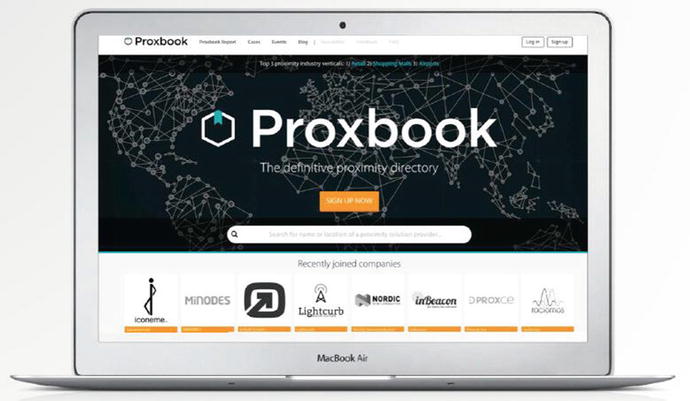
Figure 7-1.
The
www.proxbook.com
directory of PSPs
So Many Vendors, So Little Time
Why so many beacon vendors? As we saw in the prior chapters, the barrier to entry for aspiring beacon vendors is low. The silicon vendors make creating a beacon relatively easy and the huge flow of venture capital has enabled many to take that route.
Predictions are a dangerous game, but one that’s a fairly safe bet is that most of the 300 beacon providers won’t be able to survive as beacon hardware vendors
for the long run. This means that for us as solution designers, there are plenty of opportunities to pick a dud.
A Platform Decision
Your choice of beacon has significant ramifications. Once you are into the production phase of your project, you face major switching costs because while beacons are built around a set of standards, there are major gaps where solutions are still proprietary. We will highlight these areas as we review the criteria you should consider to make your choice.
When choosing a beacon vendor you are making a platform decision. The beacon is a foundation of firmware, hardware, cloud software, and hopefully a range of third-party solutions built on top of the platform. Building on a platform saves time, reduces risk (if you choose wisely), and opens up an ecosystem of third-party products that can be easily integrated.
Choose the wrong platform and you could be impacting the viability of the app that’s being developed, saddling yourself with costs and constraints that could kill your project.
So is there a single vendor that’s clearly the best? We don’t think so. We will provide a brief profile of a handful that we think deserve to be on any short list, but first we should run through the criteria to use when selecting a beacon vendor.
Some of these criteria will sound generic, or applicable to any product choice. Things like price, but in every case there is something specific to the beacosystem
that should be considered.
There is one criterion that deserves its own special place in the sun, but will be the last to be discussed in detail, and that’s volume. A quick preview: unless the number of development kits your chosen vendor has sold is in five figures, you need to look seriously at their ability to survive in the long term and at what the impact of their demise might be on your solution.
The Criteria
To make navigating the criteria manageable, we have grouped them into three clusters:
- Physical aspects of the hardware
- Firmware, software, and services
- Business aspects of your solution
Physical Aspects of the Hardware
When you start to apply this criteria, the number of viable vendors for any given requirement starts to get manageable pretty quickly.
The Case: Looks
Are looks important? They are if you are an American newscaster2 or a Bluetooth beacon. It’s amazing how many different designs have been created to package a Bluetooth beacon
. One of the first questions to answer is, do you want your beacons to be noticed or to blend into the background? As you can see in Figure 7-2, Estimote’s delicious industrial design creates an object that looks beautiful and attracts attention. Their design is arguably a major factor behind the success of the company.
Figure 7-2.
Estimote beacons are conspicuous by design
As beacons came to the notice of the press corps, no article on the subject was complete without a photograph of these colorful space-age devices. Estimote’s web site has benefited from the highest web traffic of any of the major vendors, partially as a result of the eye candy they sell. For solution providers who want to make an impression, this can be a major plus.
However, the reverse is also true. Many larger retailers have a strong desire to control the look and feel of their stores. Distracting shoppers with colorful beacons can be problematic. Gimbal’s S20 beacons
were produced in a tasteful but discrete rectangular case, with a white finish and no brand name visible. The thinking being that this will not compete with the displays on which the retailer’s professional merchandiser is trying to focus the customer’s attention.
The Gimbal beacons that have been deployed by Apple in the Apple retail stores are the same metallic finish as much of the rest of the store. You have to look carefully to see them. Shopkick’s shopBeacon achieves an appealing design aesthetic (Figure 7-3), with a white gloss finish and a curvaceous shape (to accommodate its D batteries) that can simultaneously blend in and look good.
Figure 7-3.
Shopkick beacons blend into the background despite their size
Having a beacon that is visually appealing and distinctive can make it irresistible to children who want to take “toys” home, especially if the toys have flashing lights.
Chinese vendor Sensoro
takes a similar approach with its most compact beacon, the Yunzi, shown in Figure 7-4. With its brushed steel edges, it would fit in well next to any display of high-end watches or phones. This is good because Sensoro beacons have been deployed in jewelry stores across China3.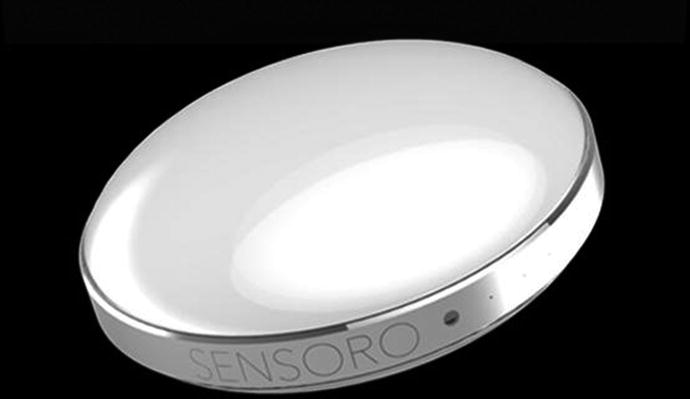
Figure 7-4.
The Sensoro Yunzi beacon
combines aesthetics with a more discrete package
This has been observed in beacon deployments at schools. The fact that the beacons were useless to the kids didn’t prevent them being “borrowed”.
The Case: Protection
The next major factor to consider is, does the beacon need to be weatherproof. Many deployments will be inside and this won’t be an issue, but there are quite a few applications where environmental conditions can be challenging: drive-throughs, parking lots, outdoor signage, statues, street furniture, car washes, and industrial facilities are all locations where beacons have been deployed and where they need a well-sealed outer shell.
If this is the case, there are standards to look for. One such standard is the International Electrotechnical Commission’s (IEC) Ingress Protection (IP) Code, International Protection Marketing IEC Standard 605294. Under this standard, a product’s protection level is designated by three numbers, although generally only the first two are used. The first number designates the level of protection against solid objects, the second deals with protection against liquids, and the third deals with impact protection. For example, IP686
is the highest level of protection against all of those factors. Check out Figure 7-5, which illustrates the qualities of an IP67 beacon case.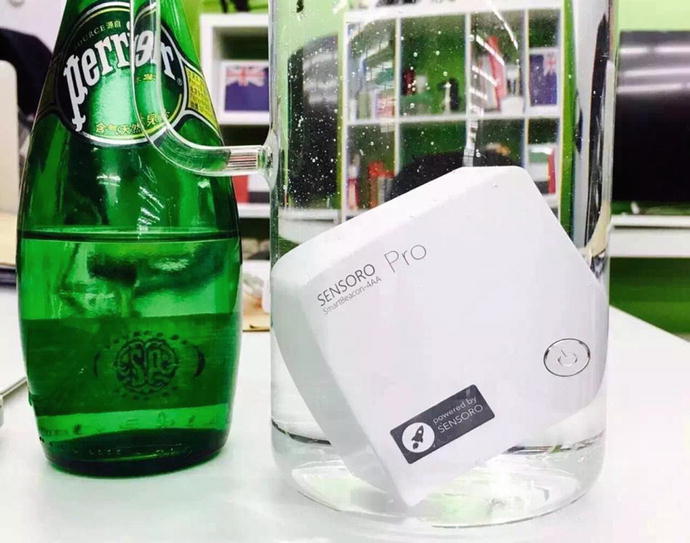
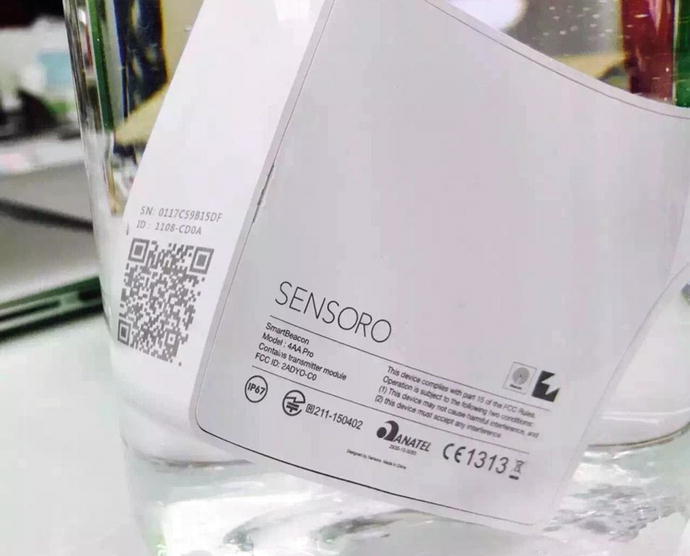
Figure 7-5.
The Sensoro Pro beacon
is designed to the IP67 standard, being waterproof and dustproof
IEC 60529: Ingress Protection Against Solid Objects
0 | No protection |
1 | Protected against solid objects up to 50mm, e.g., accidental hand contact |
2 | Protected against solid objects up to 12mm, e.g., fingers |
3 | Protected against solid objects up to 2.5mm (tools and wires) |
4 | Protected against solid objects up to 1mm (small tools and wires) |
5 | Protected against dust, limited ingress (no harmful deposit) |
6 | Totally protected against dust |
IEC 60529: Ingress Protection Against Liquid
0 | No protection |
1 | Protection against vertically falling drops of water, e.g., condensation |
2 | Protection against direct sprays of water up to 15 degrees from vertical |
3 | Protection against direct sprays of water up to 60 degrees from vertical |
4 | Protection against water sprayed from all directions—limited ingress permitted |
5 | Protection against low-pressure jets of water from all directions—limited ingress permitted |
6 | Protection against low pressure jets of water (such as use on ship decks)—limited ingress permitted |
7 | Protection against the effect of immersion between 15cm and 1m |
8 | Protection against long periods of immersion under pressure |
IEC 60529: Impact Protection
0 | No protection |
1 | Protection against 150g falling from 15cm height (0.225 joules) |
2 | Protection against 250g falling from 15cm height (0.375 joules) |
3 | Protection against 250g falling from 20cm height (0.5 joules) |
4 | Protection against 500g falling from 40cm height (2.0 joules) |
5 | Protected against 1500g falling from 40cm height (6.0 joules) |
6 | Protected against 5kg falling from 40cm height (20.0 joules) |
The United States National Electrical Manufacturers Association (NEMA)
has a standard (250-20035) for electrical enclosure types that provides an alternative benchmark. It goes beyond what might otherwise be vague assurances from a vendor. A NEMA Type 3 enclosure
is designed to “provide a degree of protection with respect to harmful effects on the equipment due to the ingress of water (rain, sleet, or snow); and that will be undamaged by the external formation of ice on the enclosure”. Type 4 enclosures provide “a degree of protection against ingress of water from a hose”. Type 6 protects against “occasional temporary submersion,” while 6P protects against occasional prolonged submersion.
There is a potential tradeoff in terms of cost and ease of access as the standards increase. Estimote’s Proximity beacon
can be completely submerged in water, but the case needs to be cut open with a knife if you want to change the batteries (as you can see in Figure 7-6).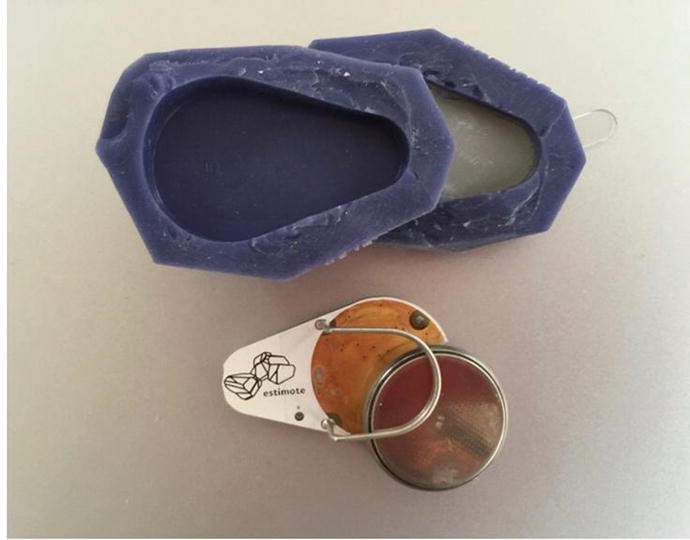
Figure 7-6.
Inside an Estimote beacon, cut open to reveal the motherboard and battery
Fixing and Physical Security
Since most beacons are relatively light in terms of weight, the most popular method of fixing them to walls is with some kind of adhesive strip, which usually comes prefixed to the case. Some vendors produce an industrial case with screw holes (see Figure 7-7) and a very few have bayonet screw sockets, the kind used to attach cameras to tripods.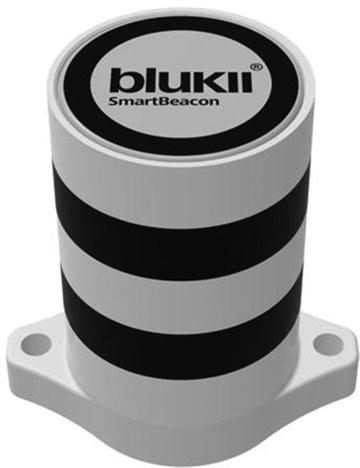
Figure 7-7.
Beacon casing with screw holes
Maybe because the cost of beacons is relatively low and they have little value to individuals, there is generally a lack of physical security such as locks to protect access to the beacon case. This would significantly increase the cost of the “bill-of-materials” for a product.
Gimbal’s S21 beacon case can be secured using a Torex tamper-resistant six point star screw head6.
Often beacons are hidden behind products, out of reach or within other more secure casings, in order to avoid tampering.
When this is done, care needs to be taken that any additional casing doesn’t interfere with the signal direction or strength. When metal sheets make up the casing of a vending machine with a beacon inside, this can create issues, whereas plastic covers shouldn’t be a problem.
Signal Strength
As we saw in the previous chapter on the chipsets used in beacons, maximum signal strength and range can vary. Achieving a 50-meter range with a strong (0dBm) signal is generally possible, assuming there are no physical obstructions that might attenuate the signal.
Chip manufacturer Silicon Labs’ Bluegiga has produced a long-range module, the BLE121LR. It transmits at +8dBm and claims to be able to achieve up to 450 meters of range. This module is used in BlueSense networks’ BlueBar beacon long-range product.
Generally beacons powered from main or USB power supplies are designed with stronger signal output, as there is no need to reduce power consumption to conserve battery life. Most beacons allow for the signal strength and thus signal range to be modulated, in order to support specific use-cases and to preserve battery life.
There can be variations in signal strength between beacons from the same manufacturer of the same model. For this reason, it’s a good idea to calibrate the signal strength of each individual beacon when deploying them for use-cases that require higher accuracy. Calibration involves measuring the received signal strength of the beacon at a specified distance (1 meter) and recording that in the setup parameters of the beacon. The RSSI number can then be broadcast by the beacon to receiving devices, so the receiver can factor this into the decision at to when to trigger actions.
Antenna
While many beacon vendors use the antennae
built into the modules provided by the chipset vendors, some have external antenna, which may more efficiently extend the signal range of the chipset.
The antenna also affects the shape of the signal. Most Bluetooth beacons have an omnidirectional antenna, meaning that the signal generation radiates fairly evenly from the devices. However, the shape of the signal is not perfectly round; it’s actually doughnut shaped
(Figure 7-8).
Figure 7-8.
The omnidirectional antennae used on most Bluetooth beacons radiate a signal that is doughnut shaped (illustration selected for memorability)
This is something to consider when positioning the beacon vertically (sideways) rather than horizontally, as the signal may not go as far as you expect if you are pointing the hole of the doughnut at the space where you want the signal to go.
There is no substitute for testing the signal with the beacon in place.
The signal from a directional antenna
is cone shaped. Unfortunately, this cone lacks clear structural integrity. Its borders are not clear-cut and there is likely to be signal radiation that comes out of the bottom of the cone. Think of an ice cream melting and the contents spilling onto your shorts (Figure 7-9).
Figure 7-9.
Directional antennas create signals that are more cone shaped
This impacts the applications
in which we can use beacons in significant ways. Consider when you have beacons in gas pumps and you want to be sure that you can differentiate between the two sides of the pump island (pump #1 versus pump #2). The directionality of the beacon on its own may not be enough to shape the signal in order to avoid a false positive effect. A false positive is where a driver is thought to be on one side of the island when they are actually on the other side. These issues can be managed and will be discussed in the chapter on beacon placement.
The Gimbal S20 and S21 beacons
have both an omnidirectional and a directional antenna. The selection of which one to use is made during the configuration process. Zebra Technologies (previously known as Motorola Solutions) offer an MB2000 beacon with directional antenna with a 120-degree beam width.
Sensors
The iBeacon specification doesn’t incorporate any support for beacon sensors, yet from early on many Bluetooth beacons have integrated a battery sensor, a temperature sensor, and an accelerometer into their design. The sensors may be configured and read using a custom Bluetooth Generic ATTribute Profile (GATT)
command. Beacon vendors provide a proprietary API that uses the profile to connect to their beacon. Google defined a more standard approach to reading the output from a basic set of sensors with the Eddystone TLM frame. This transmits just the temperature and battery level.
Sensors on beacons have proved valuable for use-cases such as measuring the weather for marketing campaigns for soft drinks, sales of which are influenced by how hot the weather is. Beacon sensors have been used to monitor the status of refrigeration units and the integrity of valuable packages shipped by logistics companies.
TI’s SensorTag
(shown in Figure 7-10) is probably one of the most “sensitive” beacons on the market. It’s attracted a lot of interest and stimulated creative projects from the “maker”7 community, due to its plethora of on-chip sensors (monitoring local temperature and battery) plus seven sensor peripheral chips integrated onto its motherboard: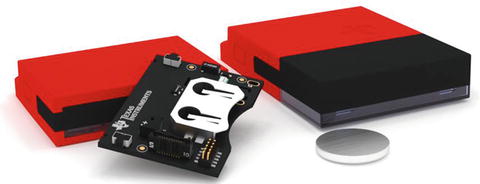
Figure 7-10.
The Texas Instrument’s CC2650 SensorTag
8
- Infra Red temperature (measuring the temperature of objects at a distance when the beacon is pointed at them)
- Accelerometer for XYZ axis measurements
- Humidity
- Barometric pressure
- Magnetometer
- Gyroscope
- Light
All this plus an LED and a buzzer make it an impressive package. It’s priced competitively at $29 for a single beacon. It appears that TI’s goal with SensorTag is to illustrate the capabilities of the underlying chipset, rather than competing aggressively with its own customers, the beacon manufacturers.
Cell Batteries and Power Beacons
The slim and economic CR2032 coin cell battery is the power source that captured the imagination of the Bluetooth low-energy ecosystem. In other cases, taking the beacon to the power and taking the power to the beacon is often not practical. But sometimes it works out. Let’s review both these options now.
Long Live the CR2032
How could such a tiny battery sustain a beacon for months of operation? The low-energy consumption of Bluetooth Smart is remarkable, and it would be even more remarkable if a CR2032 battery
could sustain beacons for more than a month when configured to meet most use-cases. Sadly, that’s not the case.
If a beacon is configured to broadcast at full power at the frequency required to conform to Apple’s iBeacon specification (10 times a second), you will be lucky to get a month of life out of that tiny CR2032.
That’s not to say that you can’t throttle back the beacon’s battery consumption to eke out a longer life. Vendors such as Estimote and Ubudu have been resourceful in making it easy to dial down the signal strength and frequency to extend battery life and to layer on other energy saving schemes, such as shutting down transmissions at times when the beacons are not likely to be needed—at night for instance.
Conversely demands on power are rising as beacons are asked to work harder by broadcasting multiple packet types to maintain compatibility with different standards. As beacons are accessed by multiple applications, supporting the lowest denominator in terms of signal strength and frequency is no longer possible. Adding management features where beacons are talking to each other in a mesh and broadcasting telematics and the CR2032 seems very limiting.
The labor cost of organizing battery changes far outweighs the savings on the battery. Vendors such as Swirl, Gimbal, Zebra, and Shopkick, with a focus on larger retail deployments, have produced devices that run off much larger batteries, to extend battery life to more than a year.
As discussed in the standards chapter, it’s necessary to broadcast beacon packets frequently (10x a second) if the goal is to ensure an app in the background detects the beacon. However, if a beacon is broadcasting Eddystone URL packets that are meant to interact with a browser running in the foreground, we can safely reduce our broadcast frequency to once a second and our battery life extends proportionately.
Battery life is complex to predict. In addition to the chemistry of the battery itself, it’s influenced by the current that is drawn, the temperature of the environment, temperature fluctuations (are your beacons going to be sitting outside in New York or San Diego), and how long the battery has been in storage9. The higher the current drawn, the more energy is lost in heat for example. We haven’t been operating beacons for 20 years, so there has been a lack of history from which to extrapolate. All this, combined with the changes in the software that is running on beacons, helps explain why vendor predictions have not always been as accurate as we would all want.
A very rough rule of thumb is that a beacon will consume over 250 milliamps a month if broadcasting 10 times a second at full power10. Using that rule of thumb, we can look at the battery capacity in Figure 7-11 and get a sense for what kind of battery packs we should be looking for in our beacon. Your mileage will vary considerably, but if in doubt (and let’s face it, we are in doubt), go for a bigger battery.
Figure 7-11.
Battery capacity in milliamps per hour (mAh)
Powered Beacons
After wallowing in the challenges of using batteries in beacons, solution designers may start to contemplate eliminating the use of battery powered beacons altogether. Being able to plug beacons into a handy power socket is frequently not possible. If that’s the case, we start to consider the feasibility in our plans of bringing the power to the places where beacons are required. Since beacons are still at an experimental phase, compelling proven ROIs are in short supply. In cases where beacons need to be placed in very specific locations in a store, laying in power cables to a new location is expensive in terms of people, capital, permits, and the union labor that is often required to deal with electrical systems. Beyond the cost, it also adds a level of complexity and disruption that makes projects a lot less likely to happen.
In cases where a single beacon is simply being used for a basic check-in use-case, placement may not be an issue. If the beacon needs to be near a point of sale terminal, a vending machine, a ticket kiosk, a gas pump, or a digital display, it’s likely there will be power available, either from a power socket or a USB connector. Power can also be obtained from network cables, with additional power over Ethernet splitter hardware that provides power to a beacon via a USB connection.
Therefore, selecting a beacon vendor that can provide the option to deploy a USB version of your beacon of choice is highly desirable.
All of the major industrial lighting companies that sell LED lighting for retail, office and industrial applications are introducing beacon offerings. GE Lighting and Acuity has been public about this. One of the things that they bring to the market is the fact that their product is already wired into power.
Firmware, Software, and Services
With so much of the hardware value being provided by the chip vendors, the software and services required for an effective beacon are the most significant technology components that differentiate beacon vendors from each other.
Beacon vendors can be divided into two broad categories:
- General-purpose beacons (e.g. Estimote, Gimbal, Kontakt.io, and Radius Networks)
- Vertically-integrated solutions (e.g. Facebook, GasBuddy, Shopkick, and Tile)
The general-purpose beacon vendors
offer a product that can be used for a very diverse set of applications. They have to provide a very broad set of features and functions to support thousands of use-cases.
The vertically-integrated solution vendors
currently don’t offer their product for developers to buy as a building block for their own solution, and because of that they can be a lot more focused in terms of the protocols they support and the tools they offer. The GasBuddy beacon isn’t for sale on the GasBuddy web site; it comes as part of a package of advertising services for convenience stores that only come from GasBuddy. Tile doesn’t have to worry about supporting the Eddystone URL standard because it’s not necessary for the solution they provide, i.e., finding lost keys, wallets, and other items from their app.
Firmware and Configuration Updates
One thing we can be sure of is that the firmware on beacons will continue to change. Protocols will evolve, energy-saving schemes will improve, management techniques will evolve, and requirements in terms of signal strength and broadcast frequency may change as new use-cases are introduced.
There are a variety of approaches to performing these updates. Assuming the beacons you have selected have flash memory (not all do), they all involve sending the updates over the air (OTA). The differences are in the distribution source and the way the transfer is initiated. There are five main approaches:
- Admin App to Device— Hard Reset . This first approach requires an administrator to perform a physical reset of the device either by pressing a button inside or outside the beacon case or removing the batteries and re-inserting them. As the beacon reboots, the admin app can then be used to transfer the changes OTA. Blesh beacons have an internal switch to do this. The Physical Web reference beacons provide an external reset button.If the beacons are situated out of reach, then ladders are obviously required. Obtaining a ladder can be more difficult than it might seem, especially when heavy security or union rules are involved. So there is a penalty in terms of time. The argument in favor of these more physical methods is that they provide a level of physical security that mitigates the risk that beacons could be hijacked by armchair based hackers.
- Admin App to Device— Software Reset . The second approach is for the beacon vendors’ administration app to be able to connect to a beacon and initiate a firmware update without any physical interaction with the beacon.BluVision, Estimote, Kontakt.io, Zebra MPact, and many other beacons support this approach.
- Wi-Fi Hub Updates . A less common approach is for the beacon vendor to use a Bluetooth to Wi-Fi gateway device. This connects to the beacons within range and then provides a cloud connection via Wi-Fi over which monitoring, configuration changes, and firmware updates can be performed. BluVision supports this approach using its BluFi Bluetooth-to-Wi-Fi sensor. Kontakt.io supports this using its Cloud Beacon. A main power socket powers the BluVision device. The Kontakt.io device is rechargeable, with 12,800mAh of capacity, or it can simply run off a USB connection. Neither device is a Wi-Fi access point; they simply provide a bridge to link to the outside world provided by a separate Wi-Fi access point.Vendors that offer Wi-Fi infrastructure (Aerohive, Aruba/HP, Cisco, Ruckus, and Zebra) are slowly integrating their management platforms so that they can monitor the presence of iBeacons. In the future it would make sense for them to be able to update the firmware and settings of beacons using that infrastructure. Given the lack of standards that apply to these update functions, this will require some strategic decisions to be made as to what beacon platforms will be supported. For Zebra, they already have a robust beacon offering MPact. As of Q4 2015, updates to beacons require an iOS device to be used, but that could change. Aerohive have partnered with Radius networks to promote plugging their powered RadBeacons into the USB port on an Aerohive router. Ruckus partnered with Gimbal to provide monitoring. Cisco, the master of corporate acquisitions, could well test the waters for its next purchase by partnering with one or two beacon providers. HP’s Aruba appears to have gone the furthest in the integration of its own USB and battery-powered Bluetooth beacons with their Wi-Fi access points, enabling configuration updates to be pushed from the access points via Bluetooth to beacons that are in range.
- Consumer App to Device . An approach that can save on the cost of sending staff out to update beacons is to crowdsource updates using your customers’ phones that are running your app. The Estimote SDK supports embedding this function in the customer’s app. It downloads the updates over the cloud and then transfers them to beacons within range that require the update. Some customers may feel this is not a reasonable approach, so exercise great caution before adopting this strategy.
- Mesh Updates . Chipset vendors such as CSR and beacon vendors such as Ubudu are promoting using mesh networks to link Bluetooth beacons. There is potential in the future for monitoring, configuration, and firmware updates to be propagated across these networks, eliminating the need to have IT staff tour all the beacons in a venue to perform these tasks.
Management
We have devoted a whole chapter to this subject, but for now lets simply register the fact that evaluating the tools provided for management by your beacon hardware provider is key. With the exception of vendors implementing Google’s Eddystone management interface, most of the management interfaces with beacons are proprietary, so management vendors can’t easily address the task of managing third-party beacons, unless there is a strategic relationship in place between the suppliers. Solution providers currently look to their beacon hardware vendors to provide the tools here.
Security/Hijacking
The aspect of security we are discussing here is the protection against “hijacking,” which is unauthorized configuration and firmware updates. This could be used to take down the proximity service and use it for unauthorized means.
This is another area where there is a lack of standards to support a cross-platform approach to authentication and prevention of such attacks. Unfortunately, there are enough standards in other areas to make hacks quite easy. Bluetooth’s Secure Simple Paring enables a handset to connect to the beacon. Passkeys used by the beacons may be broadcast in the clear, so that someone in the vicinity of the wireless conversation could then monitor this and use the password. Once connected, standard Bluetooth GATT commands can make changes to the beacon setup. Ask your vendor what they have done to defend against this.
Some don’t allow any configuration changes without physical access, others are implementing encrypted communication channels to prevent snooping on passkeys, and others are implementing industry standards such as OAuth as a way of controlling access to the beacon.
Power Consumption
The power consumption
of a beacon is a function of both hardware and firmware. It’s like the mileage of a car, a very significant factor that impacts cost and frequency of refueling which is a disruptive process. Despite the fact that there are a limited number of engines or chipsets in use and the chipset is a significant factor in the efficiency of the beacon, the chipsets is only the denominator in this equation. It’s the way the beacon designer drives that engine that is the deciding factor in the mileage you will get. Do they have “a lead foot” pushing hard on the accelerator or are they judicious in the way they use the engine cycles?
Unfortunately, there is no federal standard on how this mileage is reported and so as a buyer you need to beware. Your mileage will vary. Consider the factors already discussed and you can decide whether you think this is going to be an SUV or a hybrid. How many frame types are being broadcast? What is the frequency of broadcast? Do we have the ability to throttle back the signal strength? What’s the capacity of the batteries? There is no substitute for a test drive under the conditions that you expect to see for your application.
Operating Temperature
One other factor that will impact battery life will be the environmental temperatures
(see example Figure 7-12). Low temperatures will tend to constrain the output efficiency of the battery.
Figure 7-12.
A gauge showing the current temperature in San Diego
More fundamentally you will need to consider if there are extremes of temperature that will impact your beacon of choice and the ability for the beacon to survive at that temperature.
If you are deploying in a
shopping mall or office, this is unlikely to be an issue, but if the beacon is going to be outdoors in Minnesota or Moscow, or in a gas pump or vending machine in Arizona, it’s something to factor in. Machines like gas pumps will have been designed with extended temperature operating requirements in mind and anything that is included in those enclosures will need to operate within the same range.
Extended temperature ranges are a function of the core chipset or module, as well as the other components and circuit board that surrounds them. So just because the Bluetooth module is certified for hot temperatures, it doesn’t necessarily mean that the other components can take it.
SDK
Although theoretically developers can use the standard iBeacon and Eddystone APIs offered on iOS and Android, most major beacon vendors provide their own SDK. Before the introduction of Eddystone, this was a necessity in order to support beacons on Android, because there was no native alternative. The beacon vendor SDK also enables the access control features that have been missing from the first release of iBeacon and Eddystone.
Surely you would want to avoid using these proprietary SDKs. In theory, yes, but usually there are features you will want to access that are only available by using the beacon vendor’s SDK
. These vary in the value add that they offer, but the features can include:
- Access to sensor data
- Conditional access
- Fleet management, tracking, monitoring, and configuration
- Analytics
- Location/mapping functions—trilateration/wayfinding
- Additional proximity and location features such as geofencing
- Orchestration features: content management and campaign management
These features may represent significant value for your solution requirements, or they may be a driver for increased pricing that makes the offering less attractive. So decide up-front where you want to source these functions before paying your beacon provider extra. For those of us who are averse to sports and have had to pay our cable providers every month for ESPN,
why subject yourselves to the same annoyance of paying for features you never use with beacons?
Protocols
We discussed the iBeacon and Eddystone standards in Chapter 5, but it’s worth emphasizing that using these native protocols
offers significant benefit. There is no substitute for having access to the operating system hooks for both iOS and Android that enable control and integration with bundled apps and services that can’t be achieved otherwise. Nearly all vendors support iBeacon, but there are vendors that don’t support Eddystone, or only support a subset of Eddystone frame types. There are reasons for concern regarding Eddystone, specifically having to register the metadata about all your beacons in Google’s cloud, but that choice should be yours, not your beacon vendor’s. If the beacon vendor doesn’t support Eddystone, this should be cause for concern.
The other area to clarify is the ability to have a single beacon interleaving all protocols simultaneously. Rather than having to choose one protocol or another, you should have the option to use both. Beacon vendors may claim that there are battery issues with doing this, but this raises the question as to whether they should be offering larger batteries. It should be you as a solution designer who makes that tradeoff, rather than having your hands tied by the beacon vendor.
In addition to the protocols discussed in other chapters, there are the beacon providers’ proprietary protocols that were born prior to iBeacon (for example, Gimbal’s native protocol and Swirl’s SecureCast, which is supported along with iBeacon and Eddystone by Zebra). Zebra has done the best job of convincing other vendors to forsake their beacon offerings and use Zebra’s, so that the vendor can focus on their value add further up the solutions stack, e.g., ad networking or analytics.
Conditional Access
Conditional access
allows the beacon owner/manager to control what apps see a specific beacon. This can provide a guard against having your beacons used for showrooming, or it can be the cornerstone of the beacon networks and ad networks that we will explore later.
Not every application requires conditional access, but this has gone from an exotic differentiator to a commonplace feature. Selecting a beacon platform without this feature should be done with great care.
Now with Google releasing its Eddystone Ephemeral ID frame type, conditional access is even more broadly available. The question becomes, why would you use one of the current proprietary conditional access APIs rather than a standard that doesn’t tie you to a specific
beacon vendor?
Analytics
Beacons are often sold as analytics tools
. The reality is they are one ingredient, a cookie, a data source for analytics tools.
Analytics is a huge technology domain. It’s unlikely that a beacon hardware vendor will be able to create best-of-breed analytics tools to compete with the mutli-billion dollar corporations that already produce comprehensive suites in this area.
It’s potentially dangerous for a beacon vendor to claim analytics as a core part of its beacon offering. It could end up producing a toolset that is so poor that it reflects badly on the rest of the package and drains resources from adding value in other areas that might be a more realistic focus.
Worse, by claiming to operate in this area, vendors could alienate the ecosystem partners that they should be integrating with, that do focus on analytics. This could have the effect of removing the alternatives to what may be a sub-par analytics offering.
Does that mean the vendor should offer nothing in the way of analytics? No. There is a good argument that a beacon vendor should provide some basic dashboard tools that provide a quick, simple, economic way of understanding the use of the beacons. This can be done without declaring war with the analytics software industry.
The analytics heavyweights are not as agile as some of the beacosystem players. There are beacon-specific features that an analytics giant like SAS may not address for some time. Being able to interpret what a number of low-level beacon triggers mean and express those low-level details in ways that can be understood by other tools offers opportunities. For instance, the ability to group a collection of beacons that cover a department in a store and to export the fact that there was dwell time in men’s apparel, rather than a mass of entry and exit triggers from disparate beacons, could be very helpful.
As solution designers, we should look for evidence of integration between a given beacon vendor’s middleware and the analytics providers’ infrastructure. We can be sure that this integration will be painful the first few times it’s done, so having “plugins” between a beacon vendor’s tools and a broad selection of analytics tools is of significant value.
Integration Points
Analytics tools are just one example of where a beacon vendor can establish value with proven integrations with third-party tools. Other examples of integration points we may find interesting are with what we call
orchestration tools
(campaign management and content management), other beacon networks, advertising networks, and third-party apps. If a beacon vendor is providing a platform, they are likely to be a lot more successful if they can point to a large catalog of third-party applications and software. It’s surprising that very few of the vendors in this space can provide a solution directory that lists those partnerships.
One proxy for assessing adoption of a beacon provider’s platform by independent software vendors is to understand how many developer kits a beacon vendor has sold. Beacon vendors tend to directly equate the number of developer kits sold to the size of their ecosystem. This is optimistic. Often they don’t know if the purchaser of the beacon is an adolescent hobbyist, or the architect from a Fortune 500 company working in stealth mode. The number of developers using the beacon vendor’s development kits is important. If it’s low, that’s bad, but if it’s high, it doesn’t necessarily mean that software packages have been developed for the platform and that production systems are going to be rolled out on it. The platform that was originally used for the proof of concept is not necessarily the one used for the production system. It’s not unusual to see customers buy beacons, learn, and then “jump ship” once they become smarter.
Company
If you are buying a commodity, the kind of company you source from is not that significant. If you are buying ball bearings or beef, so long as the quality is good, it doesn’t matter so much who you buy from.
Despite the existence of standards, beacons are not a commodity, so the opposite is true. The moment you start building your solution, your source of beacons becomes really important.
Why? In the case of beacons, there are proprietary hooks that introduce unique ways of doing things. This introduces switching costs as soon as you start to invest your company’s time into designing the use of those hooks by your solution. You aren’t buying a static product. With software changes in the OS and firmware updates within the beacon, your platform will evolve. So, there are a number of factors about the company and its approach that you should consider.
Financial Viability
Most companies selling beacons are startups. Nearly all of them are burning more cash than they are making. So the one thing we can be confident of is that they will not be the same companies in two years’ time. They will either have found a way to generate profits and be self-sufficient, or they will have been bought or merged with another company with a complementary business. We have to ask ourselves, is their current focus likely to be profitable or is it a stepping-stone to an adjacent market that will be profitable? There isn’t a lot of money to be made from simply making beacons, so look at the beacosystem stack we reviewed earlier and ensure that you understand where they will extract value.
Is the answer to buy your beacons from a larger company? That may give you political cover, but the reality is that big companies can shut down underperforming divisions or sell them to companies that might not be organizations with which you want to do business. PayPal was one of the first major companies to produce a Bluetooth beacon. It was a beautiful looking product and the rationale for its existence made sense; it enhanced their payments system. They deployed it in trials, changed their leadership, and then decided the product wasn’t viable. There are rumors of a warehouse filled with PayPal beacons that have never been unpacked.
At one extreme, we have visited beacon vendors with palatial offices situated on expensive real estate. Some vendors have big teams, including industry veterans, who are clearly being well paid. Both of these may be impressive to us as prospective customers, but are signs of a high burn rate. Other areas for concern are players that are trying to develop everything themselves. None of these factors is a disqualifier, but they raise questions about how the vendor pays for these overheads.
At the other end of the spectrum we see smaller teams with offshore developers. We see teams that have started their development with a consulting services strategy that has validated their focus and funded their growth. We see companies that have focused on a sub-segment, done well, generated either volume or even cash, and then started to grow into adjacent areas. Until the beacosystem matures, investors in beacon hardware need to think like venture capitalists and consider the fortunes of the company they are investing their own capital into, even if that capital is not money but their reputation, time, and opportunity to lead.
The key questions that need to be answered are, how does this business intend to make money, how fast do they appear to be burning through their capital (political capital or money), and how realistic are their plans?
From this perspective we would want our supplier to be commanding the kind of pricing premium that will allow them to make money. Our next criterion reverses this perspective.
Cost
When looking at costs
of beacons, the equation is more complex than the unit price of the hardware.
An area to consider is one we have already touched on; whether a single beacon can accommodate all the required protocols or frame types. Some deployments have wanted to support both Eddystone URL and iBeacon protocols and have ended up deploying two beacons next to each other to achieve that. That’s certainly a cost driver.
Consider both the capital cost and the recurring cost of any services that may be charged. These recurring costs could be for the monitoring, fleet management, or conditional access. Some beacon vendors will bundle geofencing and other value-added services such as analytics and orchestration services. This may reduce expenses elsewhere, or be redundant depending on the design of the rest of the solution.
Another component is the cost of replacing batteries, or the wiring required for powered beacons. Materials and labor can vary significantly.
A fundamental question to consider as a multiplier of cost is the density of beacons required. A few beacons are all that is required to indicate presence, but to deliver pinpoint accuracy and location in X, Y, and Z axes many more beacons are required. If navigation services are all that is required based on a rules engine, then the number of beacons may be at a mid-point between these extremes. If the requirement is for triggers near specific points-of-interest, then that will drive your calculations in a different way. The numbers will be driven by the use-cases that you want to support.
Supply Chain
Even Apple with a supply chain guru
as CEO, mountains of cash, decades of experience, and huge clout with its suppliers has problems matching supply of its products with demand. Imagine the challenges for your beacon vendor. They have none of those advantages. They may have a ready supply of the processors and power supplies, but if the plastics they require have a lead time, or their contract manufacturing partner has other priorities, they may not be able to switch up supply from the trickle of developer kits to the thousands of beacons required for your project.
Maybe you don’t need thousands of beacons. If you only need a hundred beacons, does that mean you don’t need to worry? Unfortunately you still need to consider scenarios where your shipment is held hostage because a much larger customer is in short supply.
There is no magic solution to this challenge. The key is to be aware of the risk, get a sense of your beacon vendor’s business and behavior in the market, communicate with your vendor, and don’t leave it to the last moment to place your order.
Developer Community
While the current state of play continues and developers use the beacon vendor’s SDK to integrate with their products, each beacon vendor needs to develop relationships with an ecosystem of software and services partners to build out the beacosystem software stacks into complete solutions. These stacks will provide the apps and all of the other layers of functionality we define in the beacosystem stack.
To the extent that your requirements are fully defined, you can make sure that all the pieces you need work with your beacon vendor’s platform. Given that requirements change in unpredictable ways, you will want to have evidence of a broader set of solutions that are ported to your beacon platform.
Partners
Beacon vendors can’t do everything themselves. In addition to their developer community, it’s useful to understand the ecosystem of other partners that they can make available to you. Is there a choice of reputable systems integrators that have experience with their products?
Other types of partners
include advertising agencies that can help bring advertisers that might be interested in your venue’s beacon-enabled infrastructure.
Do they have partners that can help with the logistics of deploying and servicing beacons on a large scale?
Is your beacon vendor partner friendly, or are they trying to do everything themselves? Do they have competing products that might taint their ability to recruit partners to build out their ecosystem? Do they have people responsible for their partnerships? What do the partners say about the shortlisted vendors you are considering?
Relationship with OS Providers
One of the most important partnerships your vendor will have is with Apple and Google. In addition to the specifications that Google and Apple publish to describe iBeacon and Eddystone, there is information that is not public. The mobile OS behavior can change in unpredictable ways. A major beacon vendor will have relationships with insiders at Apple and Google to help them gain access to the unpublished information and respond to the unexpected changes to the mobile OS.
Beacon vendors should be able to demonstrate their participation in pilot projects working with the OS companies, early availability of support for their new standards, and even the names of the people with whom they have relationships. A strong relationship with the OS companies can help mitigate risk to your project and ensure that the best approach is being adopted with the services you require. Evidence of this kind of thing will help you to decide whether you are dealing with a tier one vendor or not.
Vertical
Beacons address a wide set of vertical markets
from automotive, banking, retail, hospitality, real-estate, transportation, theme parks, advertising, logistics, education, museums, events, hotels, and tourism. On which verticals is your beacon vendor focused? If the answer is all of them, then the reality is they have no focus. Unless their resources are truly vast, in order to provide the necessary features, partners, and best practice, they must have a focus.
Quality
Quality
of the beacon product has varied significantly between vendors. Some have a poor record of reliability. Their products are delivered with a significant percentage dead on arrival, with others failing after a short period. Other quality issues manifest themselves as inconsistency in signal stability and strength.
These issues often become visible in pilot projects. Word gets around. Some vendors may actually track their reliability and can quote Mean Time between Failure (MTBF) numbers. If they aren’t measuring this, then that is a cause for concern.
Culture
The culture of companies
in the beacosystem varies widely. Some are easy to do business with and are flexible, others are regimented sticklers for strong contractual agreements. Some companies are very guarded in discussing their results and plans, and others are transparent. It’s up to you how you interpret these signs. Robust contracts show a sign of maturity and level of quality that will result in smooth acquisitions in the future. Your vendor should be busy. So there should be limits to what they are willing to do to accommodate one customer. In early markets like the beacosystem, you are likely to be spending more time with each other than if this market were really mature, so it might be well to put your lot in with a team that you like.
Geographic Coverage
Even though beacons should work anywhere in the world, they still need local certification, support, sales, and partner management. It quickly becomes obvious if your vendor is covering your current geography, but it’s worth considering the ultimate scope of your deployment and making sure that your vendor of choice addresses all those markets.
Intellectual Property (IP) Position
There is a broad range of patent filings that read against beacons. Since very little money is being made in these early stages of the beacosystem, it doesn’t make sense for anyone to waste time with patent litigation. Many entrepreneurs don’t think it’s good use of time to cross license each other’s IP until they have a proven business model, but the time may come when it’s worth considering this eventuality, once you have made your millions. It sounds bad, but in a sense patent litigation would be a good problem to have, since it indicates that players in the beacosystem are making money.
Your beacon vendor will have exposure to competitors who have patents that they probably have not licensed. It’s useful to understand the patent filings that your vendor has made; this can help establish a balance of power, or a bargaining chip to settle disputes. Ideally the Bluetooth SIG and the OS venders will manage this issue as they have the lawyers and patent portfolios to best equip them to provide defensive cover for their developer community. In the case of the SIG, today beacons sit on top of the Bluetooth stack and so the “do not sue your fellow member” provision of the Bluetooth agreement doesn’t apply. While the OS vendors probably won’t indemnify you (defend you in court if you get sued for using their product), there is some strength in numbers if you use their protocols. Make sure in your beacon supply agreement that your supplier is offering IP indemnification.
Volume
The manufacture of Bluetooth beacons is not a boutique or craft business. Unlike the makers of luxury automobiles, musical instruments, or fine chocolates, we are not talking about an artisanal process
where dedicated craftspeople hone the delivery of a small number of beacons that have been polished and seasoned to perfection.
If a beacon vendor is not moving large volumes of product
, it’s unlikely they will have a close relationship with the OS vendors who control their destiny. Without volume, it’s even more unlikely that software vendors will adopt their platform. In a low-margin business, you do need to make it up in volume in order to be viable as a business. The companies acquiring the best-of-breed beacon vendors will be looking for a high volume of sales too.
It’s easy to produce a poor beacon. Buy the module from your silicon vendor, limit the value add software, the protocols, the management tools you provide and you can get a product out there. If, as a beacon vendor, you want to be able to do the hard work of filling all those gaps, it’s going to require a significant cash flow to fund it. That flow of cash comes from sales volume.
Some Notable Providers
There is no one vendor who covers all the bases, supporting every feature that every solution designer would need. Solution designers who want a structured listing of capabilities should use our sister resource, the Proxbook.com database, to get the latest information about vendor capabilities. It would be an easy “cop out” to leave it there.
In order to avoid that, we have gathered a list of vendors that we think are notable, that we have had occasion to become familiar with. This is a sample out of the hundreds of companies competing with each other that we think you should consider.
With each we will discuss the things we like and the tradeoffs, or “development areas,” that we see. Consider these criticisms as you would the barbed jokes in a comedy roast. We wouldn’t be saying these things if the target weren’t a significant player worthy of respect.
Just because a vendor isn’t listed here, doesn’t mean to say they are not worthy of consideration. Life is short, as is our attention span. So we have not enumerated every example of the distinctive types of vendor called out here. Enough of the disclaimers …
BluVision
BluVision
are one of the contenders for the title of “beacon vendor that has sold the most product,” with over one million beacons shipped in 2014. They have done this through a focus on two verticals, personal beacons for helping individuals finding lost items under their Stick’n’Find brand and their success in selling to a major logistics/shipping company. This was for an application where beacons were used to track the movement and care of valuable shipments. Unlike Tile, which sold even more beacons, tracking key rings and lost bicycles,
BlueVision provide beacons for venues too. They leverage the volume and cash flow from tracking assets to build a position in a market that is more about recurring services revenue.
Their expense burn rate appears to have been well matched to their revenue and they haven’t had to raise significant venture capital in their first couple of years of operation. We first met their CEO when he was staffing a small booth at the Bluetooth SIG conference. He seems grounded, frugal, and in touch with the business, willing to do the marketing work that other chief executives might think is below them.
When Google launched Eddystone, BluVision were one of the first six to be selected to support the standard. That OS vendor relationship is key.
Their hardware product portfolio is comprehensive with powered beacons and battery powered beacons with a sizable capacity. They also provide a Wi-Fi to Bluetooth bridge for remote management of beacons.
BluVision has invested in its software stack. They have experience with fleet management of large numbers of beacons; they have the conditional access layer that is required to control who can see a beacon.
Their brand lacks the slick graphics and playful industrial design of Estimote. Perhaps it is their location in Florida or their down-to-earth culture that has kept them out of the media spotlight, as compared to Estimote and Gimbal. Our estimate is that their developer portfolio and number of customers is smaller than some of the tier one vendors they are competing with. That raises some risk to their ongoing revenue stream. Their acquisition of elements of a beacon orchestration module, the marketing layer that developers can build on to save themselves time and cost, may also be a turn-off to other software developers that they compete with in this space. BluVision’s challenge is building the developer ecosystem on their platform that they need to succeed in the long term and breaking into verticals where their beacons are stationary and can form a network that can be monetized across multiple software vendors.
All of these challenges are manageable and fairly obvious, so we are excited to see their progress.
Estimote
Estimote
has succeeded in capitalizing on having its development and management team based in Poland in order to manage costs, while projecting an image of the ultimate Silicon Valley startup. They have beautiful products that compete with major film starlets in their regular appearance in magazine, blogs, and journals. The visual appeal extends beyond their product and its packaging, through to the materials on their web site. The Estimote diagram of how iBeacon works in a retail environment should get its own YouTube channel, it has been spread across the Internet that much. As a result, their web site has been visited more often than any other beacon hardware company in the first two years of the iBeacon ecosystem.
This has been backed up with cultivation of probably the largest community of developers in the beacosystem using their SDK. We believe Estimote have sold more developer kits than any other beacon vendor.
Managing beacons using their iOS app is very straightforward, with simple access to the controls to change all beacon parameters.
They have added UUID rotation and support for Eddystone to compete with other tier one vendors. Given the huge volume of developers on their platform, they have a solid basis for relationships with the OS vendors. This was evidenced by their being in the first tranche of partners that Google announced as having Eddystone support.
Estimote adds value with an Indoor Location API that allows the simple mapping of a room with beacons placed on each of the walls and then offers near real-time user positioning within the mapped space.
Their product range addresses developer and personal applications with a sealed beacon using a CR2477 coin cell battery and an “Estimote Stickers” product, shown in Figure 7-13, where 10 very thin beacons are embossed with icons to indicate the objects they can be attached to (e.g. bike, dog, car, and laptop) in order to track them.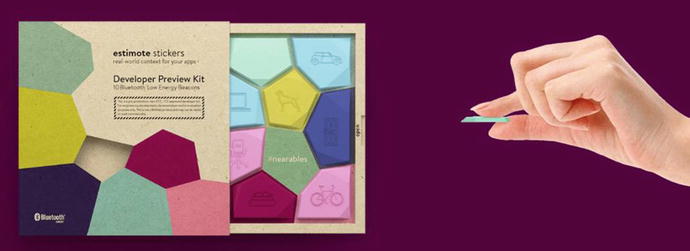
Figure 7-13.
Estimote’s Stickers product
While Estimote is arguably the leader in cultivating a developer ecosystem, the areas where Estimote has received criticism can be summed up as a product range lacking robust enterprise quality.
Their philosophy appears to center on the premise that the beacosystem is in the pilot stage and so if a beacon battery is exhausted, the device should be thrown out and replaced with the latest model.
They currently have no powered/plug-in beacons or Wi-Fi management hubs. Their maximum battery capacity is relatively small, topping out at the CR2477 coin cell level. As mentioned previously, when that battery is exhausted, the only way it can be replaced is if the beacon case is cut open with a knife. The plastic case is substantial, so that’s no small task.
Historically their quality control has been poor, with a high failure rate on arrival and after a period of use. The calibration of their beacons has been inconsistent, so that one beacon may behave differently from another in the same batch. This may have been addressed as they have gained more experience.
Other beacon vendors such as Sensoro and Gimbal have positioned their antennas as being of a higher quality, yielding greater range, and a more stable signal, which results in more predictable proximity measurement.
All that said, none of these issues is insurmountable. Having the largest developer ecosystem is a very significant advantage. New products that address enterprise requirements can be deployed quickly. Creating the largest base of developers cannot. I have spoken to solution providers who have been delighted by their experiences working with Estimote’s product.
Facebook’s launch of its Bluetooth beacon
is one of the most exciting things that has happened in the beacosystem. This is not a quick-and-dirty market test. The industrial design and packaging are beautiful.
The strategic implications for the beacon market are significant, especially as we look at the rise of the beacon network phenomenon we will discuss later. The Facebook beacon has the potential to be a great success. However Facebook isn’t likely to be selling its beacons for use by anything other than its own app any time soon. Solution designers looking for a short list of general-purpose beacons can cross Facebook off their list, for now at least.
We will revisit Facebook in the beacon network chapters.
Gimbal 11
Beacon vendors can be split into two categories based on their genesis. Those born in the bedrooms, garages, incubators, the habitat of the start-up, and those that grew out of the lab, office cube, or meeting room within an established corporate player. Gimbal is in the latter category. It was incubated within Qualcomm, the largest producer of mobile semi-conductors in the world.
As a result, it has enjoyed a lot of the privileges that go with an aristocratic upbringing, having been cultivated by experts in their respective fields of hardware design, manufacturing, legal, cloud software, and business development. Gimbal had a lot of experiences in its youth that were denied to many less privileged beacon companies. It got to go to all the best sporting events (the Super Bowl and stadiums of all the major sports leagues) and parties (South by South West); it was exposed to culture (LACMA) and as a result of its parent’s status it was introduced to business heavy weights (Google and Apple). It had a privileged place in clubs (the Bluetooth SIG). As a result of all this, it developed a sense of confidence that doubtless has helped it to gain further success, but may be off-putting for some. It’s probably also true to say that as Gimbal was carved out of Qualcomm, it brought with it a lifestyle and a spending rate that was higher than a startup pulling itself up by its bootstraps. Like any offspring from a privileged background, the expectations are high too. It puts pressure on the team to drive revenue sooner, to scale larger, and to look for the big win.
What does this mean specifically? Gimbal can probably claim more high-profile pilot wins than any other vendor. Its beacons are in all the U.S. Apple stores, the first U.S. national retail deployment of a general-purpose beacon. They have deployed hundreds of beacons around New York City in partnership with Titan. Their partnerships with major app vendors, such as RetailMeNot and Shazam, have been significant. Their experience with deployments by major advertising agencies in Japan was formative.
Their hardware lineup is comprehensive, with personal tags (the $5 S10), enterprise grade beacons (the S21, shown in Figure 7-14) with robust battery capacity (four AAs), a powered USB device, and less well known Bluetooth to Wi-Fi hub, although that is not a formal part of the hardware lineup (think of it as being on the secret menu, like Animal Style Fries at In-n-Out).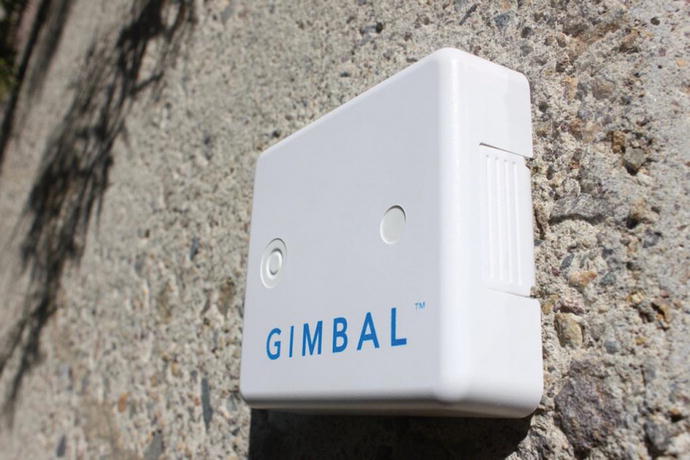
Figure 7-14.
The Gimbal S21 is powered by four AA batteries and has software selectable directional and omnidirectional antennae
The Gimbal cloud software stack may be the broadest in the industry. The product is based on a marriage between a context platform (the original Gimbal product) that predates the introduction of beacons. So it includes robust geofencing, a messaging component to send alerts to users, as well as profiling of individuals based on their movements, tracking their most popular destinations. More recently, Gimbal acquired the Phigital platform, which added what we would describe as an orchestration layer to manage the experience that is delivered by apps using Gimbal beacons.
Gimbal’s vision of building networks of beacons is exciting and ambitious.
The downsides of working with Gimbal can be inferred from their strengths and heritage. Major customers with money to spend will feel in good company. Smaller players may find it harder to get attention.
While most of Gimbal’s peer group have a Fortune 500 company behind them, Qualcomm no longer has a majority equity share. So unlike beacon companies such as HP, SK Planet/Shopkick, Zebra, and Facebook, we don’t know who will ultimately own Gimbal. It’s unlikely it will disappear—there is too much value—but companies sensitive to the agenda of a potential acquirer may be concerned. The departure of a number of key executives (and to be fair, the arrival of a cast of well qualified replacements) suggests there is considerable pressure to achieve results that may not have been fully realized.
For a solution builder that simply wants to buy hardware and create their own cloud platform to support a network strategy or middleware offering, there may be some challenges in reconciling strategies.
Gimbal’s hardware is very competitively priced because by default they charge a monthly active user fee. This isn’t unfair, given the depth of cloud service functionality available. While the structure of the fee may change, this model may not be acceptable to solution builders that simply want high quality hardware.
Lastly, to satisfy their ambitious vision, Gimbal’s market focus has been quite broad, which means a lot of the functionality is broad based, which makes it a good fit for developers building their own vertical solution. However, end users looking for a one-stop shop may find other beacon vendors have a more focused solution. Gimbal’s success is therefore predicated on their ability to partner well with third parties.
Gimbal feels like the offspring of a very demanding parent. When most kids would be happy with an A-, the Gimbal team flinches, because they know that only an A+ is acceptable.
Kontakt.io
Kontakt.io
represents a different model from Gimbal; one could say the opposite approach. It has established its strength in the European market, where it has a leadership position. Kontakt.io’s presence is becoming more established in the United States.
They have focused on monetizing beacon hardware rather than charging for active users, or building out a beacon network. Like Estimote, Kontakt.io is headquartered in Poland. Their image is rooted in a focus on cause-based solutions, with a founding story that relates to providing assistance for blind people with beacon-enabled mobile apps.
The Kontakt.io hardware
is distinguished by a Wi-Fi to Bluetooth gateway or cloud beacon (Figure 7-15) and a robust weather-resistant tough beacon.
Figure 7-15.
Kontakt.io cloud beacon provides a management gateway between its Bluetooth beacons and the ability to monitor and manage via Wi-Fi
Kontakt.io was among the first vendors to support both Eddystone and iBeacon protocols. While their industrial design is not as conspicuous as Estimote, they have a well organized developer program with the most regular production of video content to guide entrants to the beacosystem.
There are limitations to their beacons’ power options. Their beacon and tough beacon both rely on CR2477 thick coin cell batteries, which limits the battery life to six months when broadcasting at Apple’s prescribed 100ms interval.
While their initial offerings have been free from monthly recurring charges and their pricing is reasonable, the question is how they will generate revenue beyond the small margins from hardware?
Sensoro
If Gimbal’s geographic strength
is the United States and Kontakt.io’s is Europe, Sensoro’s strength is Asia. Headquartered in China, they have capitalized on the size of that market to lay claim to having deployed more beacons in venues than any other vendor (110,000 as of Q4 2015). They have announced the following:
The network spans 25 movie theatres, 16 airports, 39 high-end retail stores, 40 major tourist destinations, 200 universities, 260 high-speed trains, 1,500 Pizza Hut restaurants, and 2,100 Chow Tai Fook (CTF) jewelry retail stores among other locations.
These are significant volumes. The deployment in the Chow Tai Fook jewelry store leverages the communications app WeChat, which claims 600 million active users as of August 2015.
Sensoro
claims that its beacons triggered proximity experiences that resulted in an amazing 63% coupon conversion rate during a campaign that prompted customers to shake their phones when they entered stores to reveal special offers.
We would argue that the “network” aspect of this announcement is more aspirational than a reality today. A third party can’t yet programmatically gain access to all these beacons to launch a campaign, but no other vendor is as well positioned to achieve this in China as Sensoro is.
Sensoro’s hardware has a reputation for quality antenna design, with a strong stable signal. They are unusual in having dual antennae, with a selectable short-range antenna that is designed to enable triggers when phones come within a few centimeters of the beacon.
As well as the aesthetically-pleasing Yunzi beacon (see Figure 7-16) that runs on a CR2477 coin cell battery, with a light sensor that can be used to trigger an energy saving mode, Sensoro offers more plainly packaged beacons that run off USB power, as well as the two 4xAA battery options.
Figure 7-16.
Sensoro’s Yunzi beacons being used at a Real Madrid/Inter Milan match with more than 40,000 in attendance at the Guangzhou Tianhe Stadium
Sensoro
offers support for Eddystone and iBeacon protocols. It also offers an encryption technique to prevent unauthorized use of beacon UUID identifiers.
Currently beacon status, configuration, and software updates are achieved via an Inspection app. Going forward, they have announced a “station” that uses an additional radio technology to manage beacons within a much wider radius than can be reached through Bluetooth.
Sensoro has a small but significant staff presence in the United States and has a partnership with Microsoft, one of their original investors, which has helped raise their visibility and paved their expansion into the United States. They sold significant numbers of beacons to Google, which earns them a claim to have those all-important relationships with at least one of the key mobile OS vendors. They also have credible deployments at SeaTac airport, the Seahawks stadium, and a number of local museums.
U.S. customers must satisfy themselves that this satellite operation can support them adequately. With engineers in another time zone, and communications challenges when bridging the firewalls imposed by the Chinese government, this can raise issues if the kind of project being contemplated is pushing boundaries where collaboration across time zones is required. While the author has been impressed by Sensoro’s responsiveness, we have had challenges getting communications to penetrate China’s firewall. As they increase their presence in the United States, their challenge will be to replicate their success with WeChat in other apps with the same reach in the United States.
Sensoro
beacons are competitively priced. As of writing this, however, the shipping costs to the United States are significant for small unit volumes. That said, the cost of beacons may not be relevant. Their executives understand the value of building a true beacon network, where they own the hardware and seem open to waiving charges for hardware in order to establish placement of their beacons in key venues. Venues with significant traffic may find Sensoro willing to invest in funding the cost of beacons in their location.
Shopkick, Swirl, and inMarket
All of these vendors have significant experience with offering beacons. While Shopkick
, Swirl
, and inMarket all provide beacons, they don’t sell them as a commodity product to third-party developers. Their hardware is offered as an integral component of a retail services offering.
This recognition that the money is in the services, not the hardware, is smart but unfortunate. Shopkick’s beacon is one of this author’s favorite beacons. It is probably the largest beacon on the market, due to the sheer mass of the batteries that are packed into the device.
All three vendors have good experience with mass deployments in retail environments and were early to market with techniques to obfuscate the UUID of their beacons.
They have claimed support for iBeacon and benefit from those hooks into the OS to support the applications that use their networks, but because they don’t service the general-purpose developer community as hardware vendors they haven’t felt the need to be first in line to offer support for Eddystone.
We will explore their offers further in the beacon network chapters.
Quuppa
Quuppa is a very distinctive technology company based in Finland. Founded by ex-Nokia researchers, it offers what may be the most accurate Bluetooth beacon location technology on the market today.
Quuppa
achieves extraordinary levels of precision, down to a small number of centimeters in some cases. They do this while tracking movements at high speed, plotting the location of their Bluetooth beacons in close to real time. Visualize ice hockey players skating at full pelt around a rink, with a beacon attached to the puck rocketing between them. The players and the puck can all be tracked in the digital world, with graphical displays that keep up with the real-world action.
Quuppa does this with proprietary receivers, or “locators,” that use angle of arrival technology across an antenna array. Angle of arrival measures the difference in timing of the arrival of a signal across different elements of an antenna. If the signal arrives at the same time across all elements, it can be deduced to be perpendicular to the antenna array. As that angle changes, the timing and the phase of the arrival of the signal across the antenna differs. Based on computing that angle, the position of the signal source can be deduced (see Figure 7-17).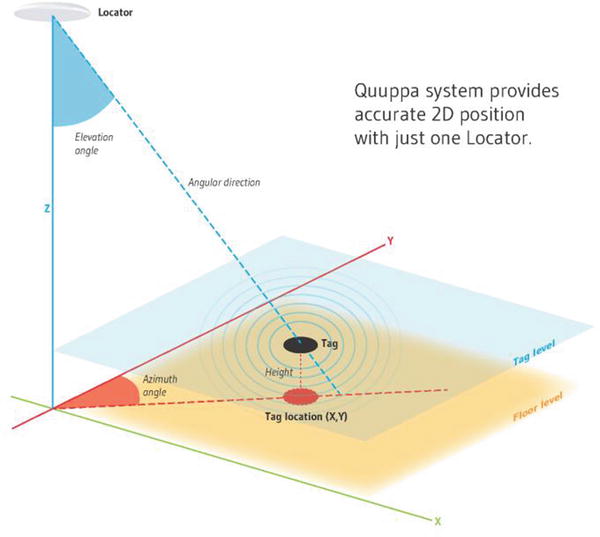
Figure 7-17.
Quuppa’s locators calculate the angle of arrival of a signal to deduce the position of a Bluetooth beacon
These antenna arrays aren’t like the sprawling antenna systems deployed by the Germans to plot the approach of enemy aircraft during World War II (Figure 7-18). They are housed in a sleek Frisbee shaped device.
This device requires a power connection. A single antenna can track location in two dimensions; add a second one to track in 3D.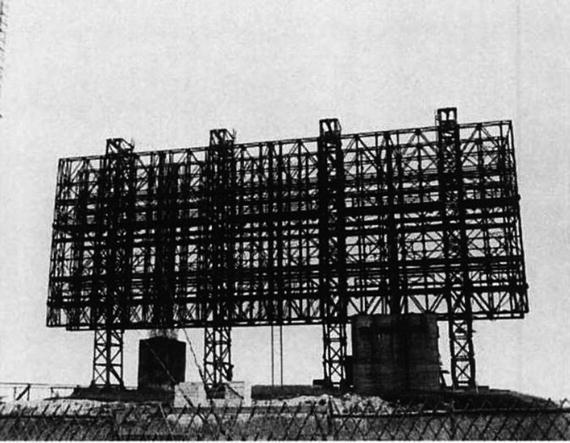
Figure 7-18.
German phased array antenna circa 1944
Quuppa is a small company (seven key staff) that works through value-added resellers who build complete solutions around Quuppa’s technology.
While the level of precision it is able to achieve is remarkable, it’s important to understand the implications of this approach. In all the other cases we have discussed here, the beacon detection is being done by a consumer’s phone, and uses signal strength to measure proximity to the beacon, whose position is fixed. With Quuppa, a stationary antenna array device (see Figure 7-19) is calculating the location of a beacon, which is the mobile component.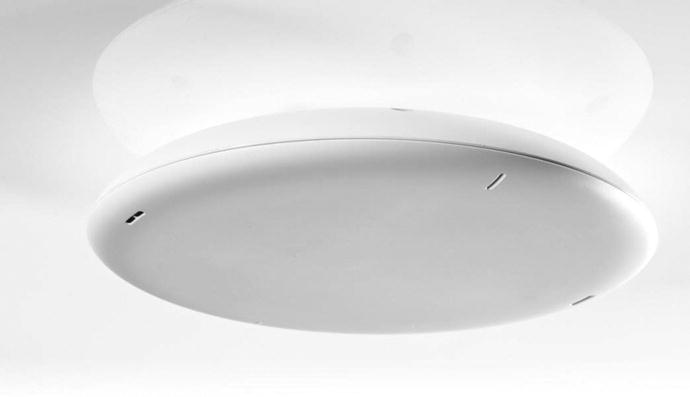
Figure 7-19.
The Quuppa receiver or locator device contains an antenna array used to pinpoint beacon location
This means that you need beacons on the objects or people that are being tracked. Of course phones can be programmed to become beacons. In which case, they can be tracked too.
There are some potential issues with consumers who may not want their phones to be activated in this way. This may be due to a number of perceived issues, including privacy and an inability for iOS devices to listen for other Bluetooth devices while transmitting as a beacon, but these are probably manageable. Attaching dedicated beacons to shopping carts in a retail use-case mitigates these risks, and also has the benefit of eliminating the need for shoppers to have a smartphone, download an app, and grant it permission to use location services.
The key difference with the conventional beacon approach is that there are more upfront infrastructure costs with this approach. The Quuppa locators are more sophisticated than a simple beacon and cost about the same as a Wi-Fi access point to purchase. They also need the same power and networking connections as those devices, which involves greater installation costs. A 100,000-foot big box store might need of the order of 100 Quuppa receivers. So if all the venue needs is simple proximity alerts, the Quuppa
solution is likely to be overkill. If there is an ROI on calculating accurate location, the upfront investment may be justifiable, especially as the maintenance costs of the fixed “locator” devices is lower than battery-powered beacon devices (no battery replacement or manual updating of firmware is necessary).
For tracking players on the field, “residents” in correctional facilities, people and assets in healthcare, along with retail heat mapping and wayfinding, the Quuppa solution has some exciting potential.
Beacon Grid
Beacon Grid’s flagship beacon
isn’t battery powered and it doesn’t plug-in, rather, it is the plug, or BeaconOutletTM that other devices plug into (Figure 7-20). This infrastructure approach is similar in philosophy to that of Acuity, Philips, and GE Lighting, which believe that Bluetooth beacons should be a feature within the wiring of a building. Rather than being built into the lighting system, Beacon Grid provides power sockets with a couple of radios inside. The advantage they claim is that their beacons can broadcast with more power, with a higher packet frequency, and with more types of packet, than their battery powered competitors. They integrate a Wi-Fi radio into their package, so that their beacons can be managed remotely and so they can provide a bridge from Bluetooth to Wi-Fi, to monitor third-party, battery-powered beacons.
Figure 7-20.
Beacon Grid beacons integrate within a U.S. power socket
As with other directly powered beacons, the location of their product is less flexible, but that still leaves a wide range of applications that can be addressed.
Although they are still a startup, Beacon Grid is seeing traction in a number of verticals. Their beacons have been integrated into systems for monitoring presence in offices and multi-dwelling units. They can provide information to better optimize heating and cooling, so that the HVAC (Heating, Ventilating, and Air Conditioning) systems only spend energy on conditioning the temperature in a room when there are people present. The physical security and ubiquity of sockets (people aren‘t likely to steal them) makes them a good fit for security applications, such as informing the e911 system where an emergency call is coming from, or fulfilling the same function for collage campus security, where students can summon help using an app in circumstances that might not warrant a call to 911.
Another interesting security application is to authenticate the presence of a person’s phone as part of an electronic system. They can allow access to secure documents via a wireless device, but only if it’s within the secure area of a government building.
Beacon Grid sees itself as a BaaS (Beacon as a Service) business where it charges a monthly fee for use of a BeaconOutlet, providing additional value with fleet management and asset tracking services, and integrations with the third parties that provide complete office, hotel, airport, and secure document applications. This is a prudent and exciting business model for them and for investors. For their customers they need a rock solid ROI to justify the $12-$40 a month that Beacon Grid charges as list prices (for small quantities).
Zebra
Zebra
was one of the first “grown-up” companies to make and sell beacons and, among other things, offers a more stable source of supply than many other younger companies in this space. By “grown-up” we mean Zebra is over 40 years old, and is a relatively large, public company, with over 7,000 employees, global reach, and billions of dollars of revenue.
Zebra’s name comes form its origins as a pioneer in barcode printing. Since then they have acquired capabilities in UWB, RFID, and Bluetooth beacons, through the acquisition of Motorola Solutions, the part of Motorola left after the company split and sold the handset business to Google. It has a broader base of retail technologies than most providers in this space.
Zebra is an example of an interesting class of beacon company, the Wi-Fi infrastructure provider (think Cisco, HP/Aruba, and Ruckus), using Wi-Fi access points as a means of managing a fleet of Bluetooth beacons.
Its beacon hardware range, MPact, encompasses USB-powered, CR 2450 coin cell and 2xAA batter units that can be controlled from a central Wi-Fi enabled server. They have succeeded in recruiting another major beacon vendor, Swirl, to use their beacon hardware by offering support for Swirl’s proprietary SecureCast protocol. This protocol allows access to beacons to be regulated.
Their MB2000, AA-battery powered beacon is one of the few such devices that uses a directional antenna and uses “a next generation chipset” that should yield a two-year battery life even when broadcasting at 100ms intervals.
The platform includes location and analytics software. Zebra has done a good job of emphasizing its ecosystem partners (Coffee Bean, Phunware, Swirl, Aisle411, Localpoint by Digby, Codigo, and Retailigence) who have built on the Zebra platform in ways that other beacon vendors have struggled to do.
Zebra’s
strengths may also provide clues to its weaknesses. It is surprising that there is a lack of case studies and announcements of customer deployments using this comprehensive platform. One can only guess that with its size, the fog of war associated with the Motorola acquisition and the sheer breadth of its offering, that a lack of focus may be causing it to move more slowly in converting its existing customer base over to beacon technology. Having account managers with existing relationships based on purchases of other products is hugely valuable, but with it comes opportunities for internal politicking and change management issues that smaller companies don’t experience to the same extent.
If Zebra’s executives continue to believe in the opportunity and succeed in generating the profits to justify that patience, the company could be well placed to service accounts that appreciate its many strengths. These include breadth of product, size, focus on beacon management, and being a supplier with a more certain future.
Summary
Beacons are a fairly simple hardware component in a proximity solution with many layers. The vendors stand on the shoulders of silicon manufacturers who provide them with an impressive baseline platform to build on. There are hundreds of beacon vendors to choose from. However, if you consider the criteria we have described in this chapter, it’s possible to select a small number that have the hardware, software, and business profile to deliver what is needed for your solution to be successful.
Along with selecting which beacon to use come questions about deploying, what could be, thousands of wireless devices. These devices have to support a set of applications that are new and will probably change over time. How do you prepare for that? This is the next question we consider in our Hitchhiker’s Guide to the Beacosystem.
Footnotes
1
Proxbook is a crowdsourced listing of PSPs that grew out of a realization that any list of beacon providers we captured in these pages would be out of date before the publisher’s CMS could send its pages to the print-on-demand service. Our clunky WordPress database was then adopted by the folks at Unacast, taking the crowdsourced database from 80 PSPs to over 300. So strictly speaking we are the birth parents of
www.proxbook.com
(which has since been adopted by wealthier parents), not the sibling.
2
I personally prefer newscasters who have bad teeth and rumpled clothing; it shows they are focused on journalism rather than hairspray and were clearly promoted on that basis.
3
The beacons enabled a campaign at 237 of Chow Tai Fook’s 2,300+ jewelry stores in China. This drove the presentation of over 24,000 coupons and $16 million of sales revenue during the Chinese New Year. Check out the case study, full of specific metrics, at post.sensoro.com/case-study-for-monetized-beacon-deployment-in-china/.
4
The British Standards Institute online store provides a copy of this 48-page standard shop.bsigroup.com/ProductDetail/?pid=000000000030214185
8
Image courtesy of Texas Instruments. Image cropped and used under license creativecommons.org/licenses/by-sa/3.0/.
9
Energizer’s handbook on battery technologies provides a lot more detail
http://data.energizer.com/PDFs/alkaline_appman.pdf
10
We have already discussed the multitude of variables, including the chipset technology, but in this case let’s throw caution to the wind in the interest of figuring out the battery requirements at a gross level.
11
Full disclosure: As noted elsewhere, the author worked at Qualcomm as Senior Director of Strategy for Qualcomm Retail Solutions, the division that incubated Gimbal prior to its carve out from that company.
